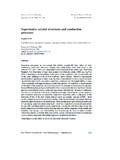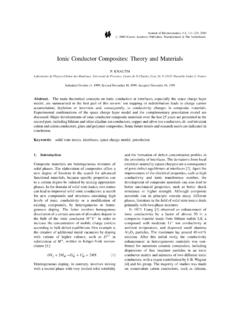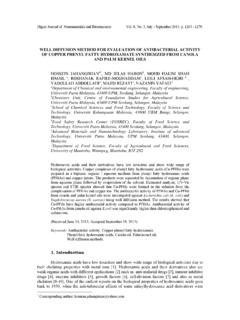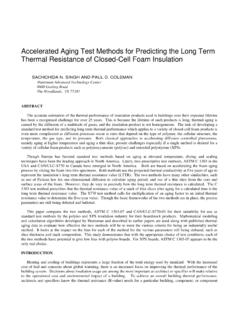Transcription of Ionic Conductor Composites: Theory and Materials
1 Journal of Electroceramics 5:2, 111 125, 2000#2000 Kluwer Academic Publishers. Manufactured in The Conductor Composites: Theory and MaterialsP. KNAUTHL aboratoire de Physico-Chimie des Mate riaux, Universite de Provence, Centre de St Charles, Case 26, F-13331 Marseille Cedex 3, FranceSubmitted October 14, 1999; Revised November 18, 1999; Accepted November 18, main theoretical concepts on Ionic conduction at interfaces, especially the space charge layermodel, are summarized in the rst part of this review: ion trapping or redistribution leads to charge carrieraccumulation, depletion or inversion and, consequently, to conductivity changes in composite con rmations of the space charge layer model and the complementary percolation model arediscussed.
2 Major developments of Ionic Conductor composite Materials over the last 25 years are presented in thesecond part, including lithium and other alkaline ion conductors, copper and silver ion conductors, di- and trivalentcation and anion conductors, glass and polymer composites. Some future trends and research needs are indicated :solid state ionics, interfaces, space charge model, Materials are heterogeneous mixtures ofsolid phases. The elaboration of composites offers anew degree of freedom in the search for advancedfunctional Materials , because speci c properties canto a certain degree be tailored by mixing appropriatephases. In the domain of solid state ionics, two routescan lead to improved solid Ionic conductors: a searchfor new compounds and structures sustaining highlevels of Ionic conductivity or a modi cation ofexisting compounds, by heterogeneous or homo-geneous doping.
3 The latter involves homogenousdissolution of a certain amount of aliovalent dopant inthe bulk of the Ionic conductorM X in order toincrease the concentration of mobile charge carriersaccording to bulk defect equilibrium. One example isthe creation of additional metal vacancies by dopingwith cations of higher valence, such asD2 insubstitution ofM , written in Kro ger-Vink nomen-clature [1]:DX2 2MM?D?M V0M 2MX 1 Heterogeneous doping, in contrary, involves mixingwith a second phase with very limited solid solubilityand the formation of defect concentration pro les inthe proximity of interfaces. The deviations from localelectrical neutrality (space charges) are a consequenceof point defect equilibrium at interfaces [2].
4 Apart theimprovement of the electrical properties, such as highconductivity and Ionic transference number, thedevelopment of composite Materials can also lead tobetter mechanical properties, such as better shockresistance or higher strength. Although compositematerials can in principle contain many differentphases, literature in the eld of solid state ionics dealsprimarily with two-phase 1973, Liang [3] observed an enhancement ofionic conductivity by a factor of almost 50 in acomposite material made from lithium iodide LiI, acompound with moderate Li ion conductivity atambient temperature, and dispersed small aluminaAl2O3particles. The maximum lay around 40 vol %alumina.
5 After this initial study, the conductivityenhancement in heterogeneous Materials was con- rmed for numerous ceramic composites, includingdispersions of ne insulator particles in an ionicconductor matrix and mixtures of two different ionicconductors, with a major contribution by J. B. Wagner[4] and his group. The majority of studies was madeon monovalent cation conductors, such as lithium,silver and copper halides, the largest group beinglithium compounds, given their importance in highenergy density portable batteries. Besides Al2O3,other oxides, such as MgO, SiO2, CeO2, TiO2andferroelectric BaTiO3, were found to be effectivesecond phases for Ionic conductivity recently, the composite effect was also observedin ceramic anion conductors, such as lead or calcium uoride, and even in inorganic solids with trivalentcation conductivity, like aluminium and Theory of Ionic Conductor composites, whichis developed in the rst part, highlights theimportance of phase boundaries for the electricalproperties.
6 Boundaries can be transport pathways ortransportbarriers,giventheirmodi edcorestructure (core effects), and can affect the chargecarrier distribution in the adjacent regions (spacecharge effects). Local deviations from electricalneutrality in the vicinity of interfaces wererecognized long time ago in the electrochemistryof liquid electrolytes or in colloidal systems. Gouy[5] established the Theory of the electrical doublelayer at the electrode-electrolyte interface already in1903 and Overbeek and co-workers [6] theelectrostatic colloid Theory in 1948. Lehovec [7]calculated in 1953 the defect distribution at thesurface of Ionic crystals and discussed the implica-tions for Ionic conduction.
7 In 1972, Wagner [8]used the space charge layer concept to explainconductivity effects in two-phase Materials withelectronic conduction, such as metallic inclusions ina semiconducting oxide or mixtures of twosemiconducting oxides. After an attempt by Jowand Wagner in 1979 [9], Maier [2,10,11] establishedthe space charge layer Theory of heterogeneousionic conductors after the second part, we present important investiga-tions of Ionic Conductor composites since Liang'sinitial study 25 years ago. Ceramic composites, whichare mixtures of two crystalline inorganic phases,represent so far the most important group in solid stateionics, but a growing amount of work was recentlydevoted to glass-ceramic composites, obtained bypartial crystallization of a glassy matrix, and polymer-ceramic composites, where an inorganic compound isdispersed in a polymer matrix.
8 Agrawal and Gupta[12] recently reviewed composite solid electrolytesand gave an extensive list of systems reported in of Ionic Conduction in CompositesInterfaces play an important role for the transportproperties of polycrystalline and polyphase (compo-site) Materials . Given the anisotropy of boundaries,one has to distinguish between transport along andacross interfaces. Enhanced Ionic conduction alonginterfaces can be observed for two , the interface core itself is a disordered region,where defect formation and migration energies aregenerally notably reduced. This leads to enhancedionic transport within the interface core (grainboundary diffusion). However, core effects aregenerally small, given the reduced interface area inconventional microcrystalline Materials (*d/L,where boundary core widthd& nm and grainsizeL&1mm).
9 Some studies established the role ofgrain boundary diffusion in polycrystalline oxides,including NiO, Al2O3, MgO [13] or ZnO [14], butthere seems to be no similar study in , point defect and dopant interactions withinterfaces, for example accumulation in the interfacecore (intrinsic and extrinsic interfacial segregation),induce concentration pro les of point defects in theregions adjacent to the interface in Ionic Materials (space charge layers). Only few quantitative studiesexist on grain boundary segregation in oxides,including CaO-doped ZrO2[15], TiO2[16] andCeO2[17], and similar studies on phase boundariesin composite Materials are even more dif cult, froman experimental as well as a theoretical point of concentration pro les of mobile charge carriersnear interfaces are a consequence of thermodynamicdefect equilibrium, as we will see Charge Layer ModelThe fundamental concept is that ions can be trapped atthe interface core.
10 (This process is equivalent to asegregation phenomenon.) The counter species, ingeneral a trapped ion vacancy, is then accumulated inthe adjacent space charge regions. Driving force is thechemical af nity of a second phase to the trapped example, ``basic'' oxides present many nucleo-philic hydroxide surface groups, which can attract and x space charge layer concept is a naturalextension of volume defect thermodynamics, whichtakes the defect equilibrium at grain or phase112 Knauthboundaries into account [2,10,11]. Assuming an ionicsolidM X with Frenkel disorder, the bulk defectequilibrium:MM Vi?M?i V0M 2 is established between metal interstitialsM?iandmetal vacanciesVM0.









